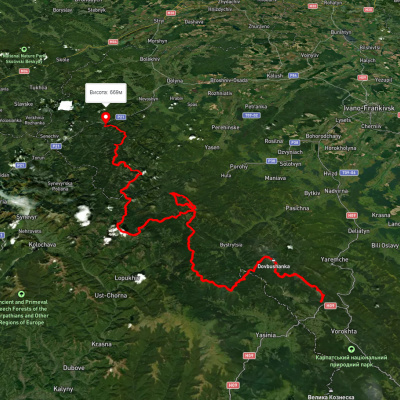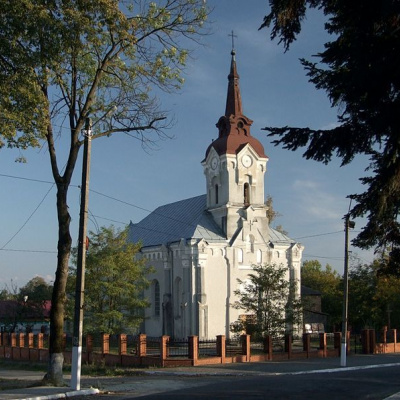Church of the Nativity of the Virgin Mary, Dolyna
The oldest church in Dolyna, a landmark of the region, is the Church of the Nativity of the Virgin Mary on Antonovycha Street. After the foundation of the Roman Catholic parish in 1426, the locals built another wooden church in the suburbs, but modern historians do not know exactly where. It is assumed that today there is a school number 1. Beautiful views open from the hill where the building is located.
The church has existed since 1426, but it has undergone many restorations and renovations, so today it looks completely different. The wooden church burned down in 1594 as a result of arson by the Tatars. A new church was built on the same site in 1674.
According to the documents, the Dolyna church was in a very poor condition, and until 1825 no one was engaged in its restoration, so it was decided to rebuild the building again, but for this purpose a place was chosen in another part of the city. The construction of the brick church called "The Nativity of the Most Holy Virgin Mary," which can still be admired today, dates back to 1835. The building was blessed by priest Thomas Lewandowski.
The church is a one-nave building built in the Gothic style, with a total length of 34 m and a width of 14 m. The interior space ends in an apse with an altar. The walls are 0.95 m thick. The apse is adjoined by two rectangular rooms for the church's ministers, added in 1883. The interior walls are divided by pilasters with a cross-section of 1.0 x 1.0 m. The height of the main hall is 8.0 m.
The entrance to the church is accentuated by a tower, which rests on two powerful, rectangular rooms. One of them has a staircase to a spacious balcony where the organ used to be, and the other has a boiler room and storage rooms. The stairs continue into the middle of the tower. They served to service the clock and bells. The outer walls are divided by semi-columns of square section, measuring 0.5 x 1.0 m in plan. At a height of 4.0 m, they narrow and end with a triangular roof, which is adjacent to the main roof. The height of the building to the roof ridge is 14 m. The height of the tower is 28 m.
It is not known who designed the church and who was the master of its construction, but the fact that the project was not successful, especially the construction of the foundations, was shown by subsequent events. The church's inventory book contained a description of the beginning of construction based on eyewitness accounts.
The foundation of the building was laid of river stone, mostly round, which was laid in dug trenches without any binding materials. The walls of the church and the vault were made of brick. There was no waterproofing between the walls and the foundation. The construction was completed fairly quickly for such a large building, in three years. The altar in the church was large; it was moved from the old church, as was the organ. The organ was made in 1808, and in 1838 it was repaired by Matii Savytskyi, a resident of Obolonia village. Unfortunately, the organ was lost. The church was consecrated by priest Franciszek de Paulo Pisztek, archbishop, Metropolitan of Lviv.
The poor foundation reminded us of itself in the third year. A brick vault collapsed and the new building had to be repaired. To strengthen the walls, powerful pilasters were built in the middle of the room, on which a new wooden ceiling rests, fastened with metal anchors. But the troubles did not end there. In 1886, the bells were removed from the church tower and installed in a separate bell tower, as large cracks appeared in the tower walls. A project to strengthen the tower was developed. Already in 1889, fortification works were carried out, the main tower was strengthened and completed, the windows of the church were extended, and a clock was installed.
In connection with the completion of two side rooms, the altar had to be partially remodeled. The church happily survived the tragic events of the First World War. With the occupation of Dolyna by the Poles in 1920 and the stabilization of public life, the Poles began to improve the appearance of the church.
In 1934, the wall paintings were restored, and on the initiative of the priest Wojnarowicz, the forefather of Dolyna, a stone bell tower was built with the help of the legate, priest Zaremba, in place of the wooden one. It stood near Antonovycha Street, on the right side of the entrance. Its walls were made of hewn gray sandstone. The bell tower was 5 meters long, 1.5 meters wide, and had 4 bells. It was dismantled in 1965. It is unknown where the bells went, perhaps they were taken by the Germans during the war.
In 1944, the Poles were resettled to Poland, and the church was closed. At first it was used as a grain warehouse, which was donated by the population of the district (contingent), and then in 1948 it was transferred to a school as a gymnasium.
With the collapse of the Soviet Union and the democratization of society, the Poles who remained in Dolyna petitioned for the return of their shrine, which was done in 1990. But perseverance and hard work changed the appearance of the building for the better every day. The restoration of the interior began. In 1991, an old altar was brought from Ivano-Frankivsk. It was presented by Dean Kazymyr Halimurka. The church was consecrated on December 27, 1991, and a service was held here on the same day.
In 1992, the roof was repaired. The old tin was removed. The small, almost destroyed tower was dismantled. The roof was covered with new galvanized tin. New gutters were installed. Due to roof leaks and lack of drainage, a "fungus" appeared in the house, which destroyed the floor and began to destroy the walls. To remedy the situation, it was decided to build a drainage system around the house. The drainage system was built in 1993-1994. Trenches were dug to the depth of the foundation sole, asbestos-cement and ceramic pipes were laid and covered with rubble. The water from the drainage system was discharged to Zelena Street.
This work was very risky. The foundation, which was open to the full height on one side, could have cracked. But everything went well. The discovery of the foundation confirmed the entries in the church's inventory book, that is, that the foundation was made of river stone with clay filling, and was unreliable for such a large structure. In 1994, a new terrazzo plaster of the exterior walls was made. The plastering was done by craftsmen from Zakarpattia. In 1995-1996, the tin on the main tower was painted brown. The paintings inside the church were restored. A new altar was designed and installed. It was designed by Mr. M. Dekalsky from Lviv, an employee of the restoration workshops. Together with the workers of this enterprise, the altar was installed in the church. The main image of the altar, "The Image of the Nativity of the Blessed Virgin Mary," was made by a resident of Kalush, Mrs. Maria Andriyshyn. The bell for the church was brought from the city of Tatsiszew, Poland. There is a workshop of the Filchynskys, who are from Kalush and have extensive experience in casting loud and resounding bells.
February 1998 was very warm, and the Poles decided to put the fence of the territory in order. The fence had been destroyed by tree roots and previous owners. The linden trees were already old, hollow, and had been barbarically cut by electricians more than once when cleaning the power lines. They were cut down, and the stumps were dug up and taken away. The old fence was dismantled and a new metal fence on brick pillars was installed. The floor is laid with white and black marble. It is still necessary to repair the tower inside, restore the clock and put it back in its place if possible.
A majestic song of gratitude to God is once again being sung in the church. It entered the new millennium restored, in all its glory.
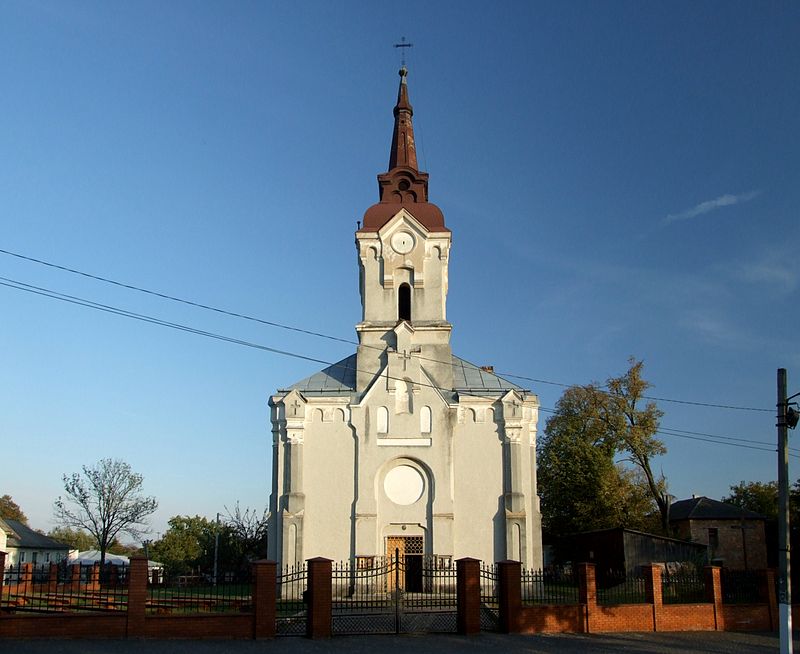
Be sure to visit the museum-hideout of the insurgent victory and the Dolyna Museum of Local Lore of Tetiana and Omelian Antonovych Boykivshchyna, one of the youngest museums in the Carpathian region, founded in 1998. The museum's experienced guides will help you organize sightseeing tours of Dolyna region if you want to see the bunker where Ukrainian nationalists were hiding, the Carpathian Tram in Vyhoda, Dovbush's Rocks in Bubnyshche or Hoshiv Monastery, Ivan Franko Museum in Lolyn village.
Accommodation around Church of the Nativity of the Virgin Mary, Dolyna:
Які маршрути проходять повз Church of the Nativity of the Virgin Mary, Dolyna?
Пропонуємо пройти такі туристичні (пішохідні) маршрути через/біля Church of the Nativity of the Virgin Mary, Dolyna: Маршрут на г. Щавна, На Горган Ілемський, с. Мислівка – г. Горган-Ілемський – с. Мислівка, с. Мислівка, через хр. Аршиця, г. Молода, г. Яйко-Ілемське до с. Мислівка, с. Татарів, через г. Синяк, г. Довбушанка, г. Чорна Клева, г. Братківська, г. Сивуля, г. Кінець Горгану, г. Попадя, г. Грофа до с. Мислівка, с. Мислівка, через г. Яйко Ілемське, г. Горган Ілемський до с. Мислівка
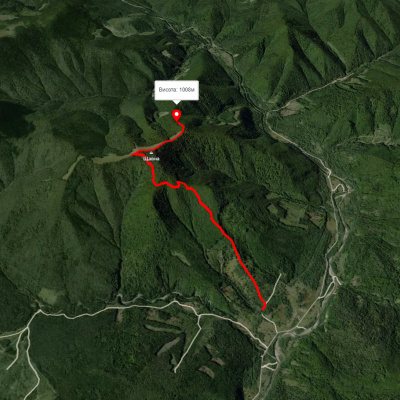
Маршрут на г. Щавна

На Горган Ілемський
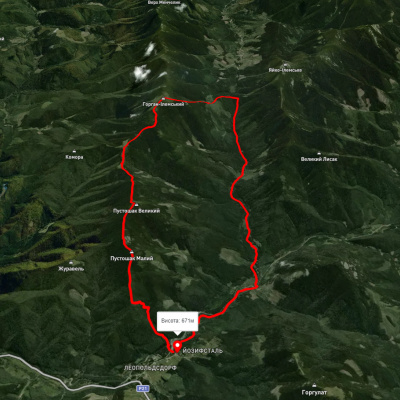
с. Мислівка – г. Горган-Ілемський – с. Мислівка
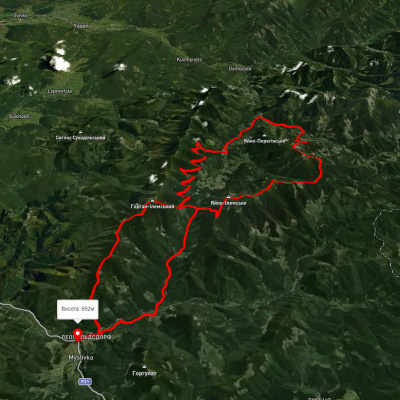
с. Мислівка, через хр. Аршиця, г. Молода, г. Яйко-Ілемське до с. Мислівка
